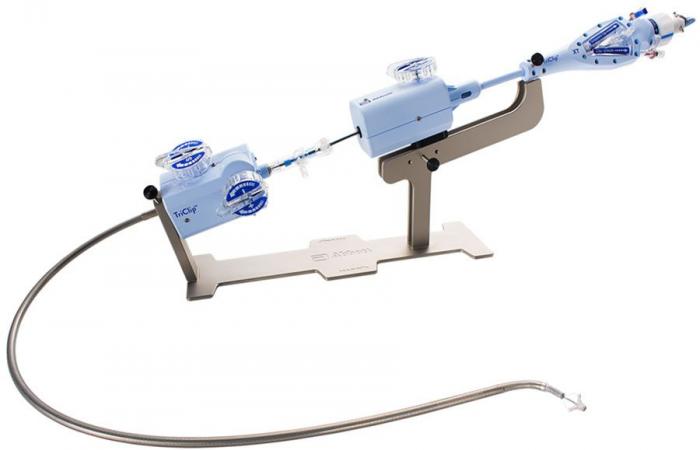Tricuspid insufficiency (TI) is a disease of the tricuspid valve, quite common and associated with a poor prognosis. It affects approximately 0.8% of the general population. Its incidence increases markedly with age. 4% of patients over 75 are affected. Since April 4, 2024, Poitiers University Hospital has been offering a new treatment: the TripClip technique (Abbott Cardiovascular).
Tricuspid insufficiency is linked to a leak in the tricuspid valve[1] located between the right atrium and the right ventricle, causing abnormal blood reflux from the right ventricle to the right atrium. In 85% of cases, it is functional and, most frequently, secondary to a pathology of the left heart (valvular disease of the left heart, failure of the left ventricle): an arrhythmia by atrial fibrillation, a pulmonary disease, pulmonary hypertension, or the presence of a cardiac stimulation probe (pace maker or defibrillator). Pathologies of the left heart eventually cause a dilation of the right heart cavities favoring the occurrence and worsening of tricuspid regurgitation.
Severe tricuspid insufficiency leads to the appearance of signs of right heart failure with weight gain linked to water retention, shortness of breath, fatigue, edema of the lower limbs. It facilitates the occurrence of rhythm disorders, kidney and liver failure. It therefore leads to repeated hospitalizations with a very poor quality of life. At an advanced stage, severe tricuspid regurgitation is associated with a poor prognosis with a mortality rate close to 60% at one year, directly correlated with the degree of tricuspid leak.
In practice, conventional cardiac surgery, recommended for the treatment of severe tricuspid regurgitation, is rarely performed (5%) due to the high operative risk (mortality at one month estimated at between 8 and 10%). Since April 4, Poitiers University Hospital has been practicing the TriClip technique of percutaneous valve repair, which constitutes a therapeutic alternative for symptomatic patients, despite optimal medical treatment and considered to be at high operative risk. It is intended for patients suffering from tricuspid regurgitation who are not eligible for conventional surgical treatment. This new technique is offered thanks to specific funding, as this device is not yet reimbursed by Social Security. It is performed by Drs. Jean Mergy and Elisa Larrieu, cardiologists, in close collaboration with Drs. Corinne Beaufort and Benjamin Alos, sonographers.
The TriClip system is directly inspired by the MitraClip system (edge-to-edge repair of the mitral valve) which has demonstrated its effectiveness and safety in the treatment of mitral insufficiency for several years.
The objective of the TriClip technique is to restore alignment of the valve leaflets in the leak area using clips, or “clamps”, and thus reduce the tricuspid leak. It is carried out by inserting a catheter fitted with the clip through a femoral venous route, at the level of the groin fold, under general anesthesia, without resorting to opening the thorax and therefore without sternotomy. General anesthesia is driven by the need for transesophageal ultrasound during the procedure to guide placement of the clips on the tricuspid valve. Depending on the anatomy and the type of tricuspid leak, the implantation of several clips is often necessary. TriClip treatment showed a reduction in tricuspid leak associated with a reduction in heart failure symptoms, leading to an improvement in patient quality of life and a reduction in hospitalizations..
The TriClip device is an innovative treatment. It offers a real possibility of tricuspid valve repair in symptomatic patients who suffer from tricuspid regurgitation despite well-conducted medical treatment and who cannot benefit from cardiac surgery due to a significant operative risk.
[1] The tricuspid valve is one of four valves that make up the heart along with the pulmonary, aortic, and mitral valves.
Photos from Abbott lab.
Share the post “TripClip technique to treat tricuspid insufficiency”






